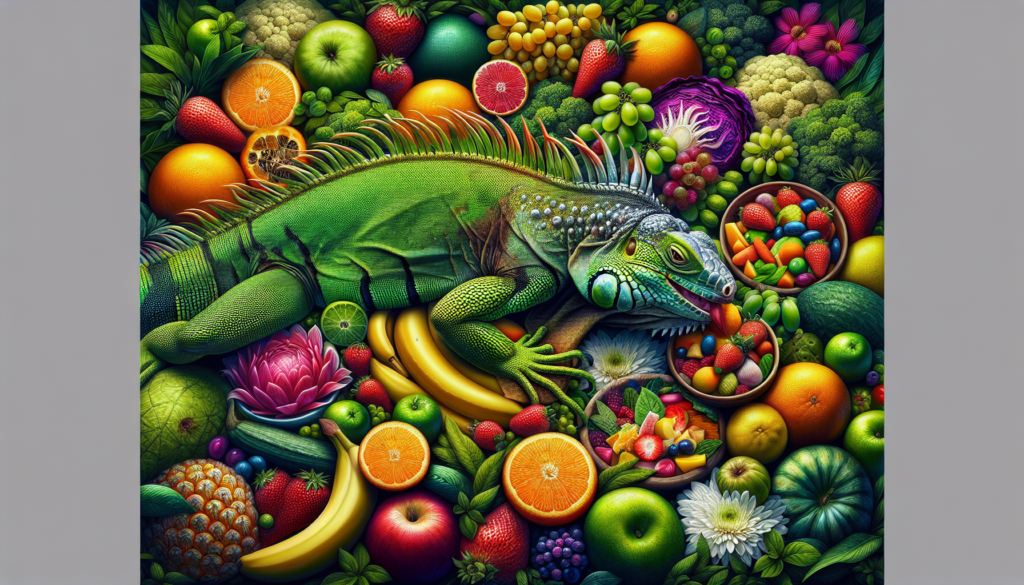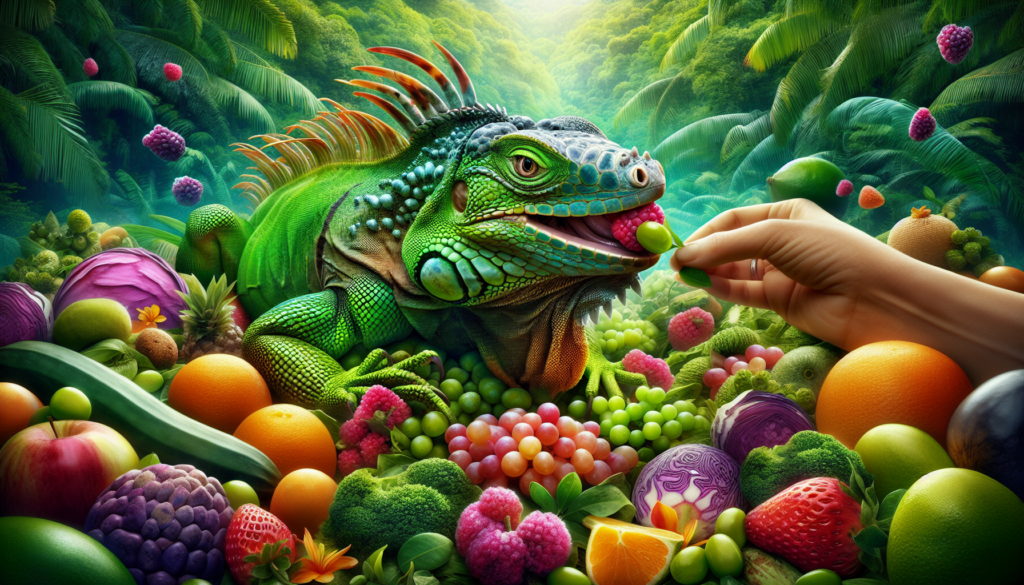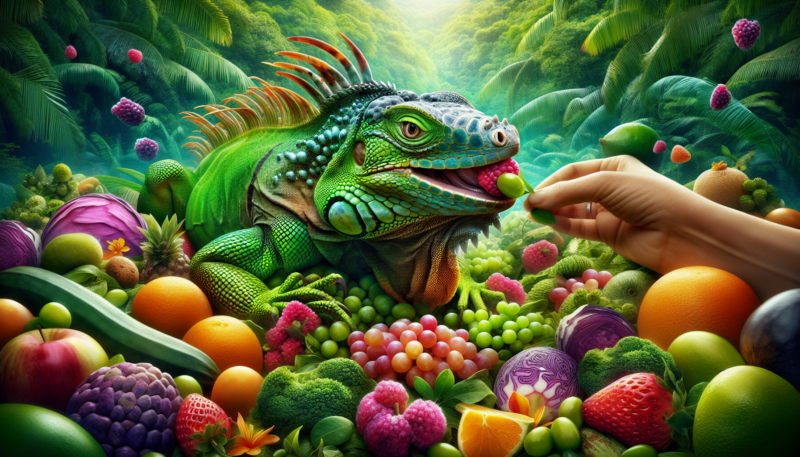Did you know that the diet of green iguanas is not what you might expect? Contrary to popular belief, these reptiles are not solely herbivorous, as they have been known to consume a surprisingly wide variety of foods. While they do have a preference for leafy greens and fruits, their diet also includes insects, small vertebrates, and even carrion. In this article, we will explore the fascinating eating habits of green iguanas and the reasons behind their diverse menu choices. Prepare to be amazed by these unexpected dietary revelations!

Overview of the Green Iguana
Green iguanas, also known as the American iguana, are fascinating reptiles that inhabit the rainforests of Central and South America. With their striking green coloration, these arboreal creatures are known for their unique physical characteristics, habitat preferences, and captivating behaviors.
Physical characteristics
The green iguana boasts a robust body covered in rough, spiky scales, providing them with a protective layer against predators. They have elongated bodies, reaching an impressive length of up to six feet, with their slender tails making up two-thirds of their total length. Their strong jaws are equipped with sharp teeth used for biting and tearing vegetation.
One of their most prominent features is their crest of spines running along their back to the tip of their tail. This distinctive feature sets them apart from other reptiles and aids in regulating body temperature. Green iguanas also possess a dewlap, a large flap of skin under their chin that they use to communicate and regulate body temperature.
Habitat and distribution
Green iguanas are predominantly found in the rainforests of Central America, including countries such as Costa Rica, Honduras, and Panama, as well as parts of South America, including Brazil and Venezuela. They are arboreal creatures, meaning they spend a significant amount of their time in trees. These reptiles can be found in lush, tropical environments near bodies of water, such as rivers and lagoons, where they bask in the sun and swim to regulate their body temperature.
Behavior and lifestyle
Green iguanas are diurnal creatures, meaning they are active during the day. They are social animals that often form colonies, particularly during the breeding season. Males are known to be territorial and exhibit aggressive behavior towards other males, while females are more tolerant and often share nesting sites.
These reptiles are excellent climbers and swimmers, allowing them to navigate their surroundings with ease. However, they are also adept at burrowing and can dig complex tunnels to seek shelter or lay their eggs. Green iguanas rely on basking in the sun to regulate their body temperature, often perching on branches or rocks to soak up the warmth.
Importance of Diet for Green Iguanas
A balanced and nutritious diet is crucial for the overall health and well-being of green iguanas. As herbivores, these reptiles have specific nutritional requirements that must be met to ensure optimal growth, reproduction, and overall vitality.
Nutritional requirements
Green iguanas require a diet rich in essential nutrients, including carbohydrates, fiber, vitamins, and minerals. They need adequate amounts of calcium and vitamin D to maintain strong bones and prevent metabolic bone disease. Additionally, they rely on an appropriate balance of protein-rich foods to support muscle development and overall bodily functions.
Impacts of diet on health
A well-rounded diet has a direct impact on the health of green iguanas. Insufficient or imbalanced nutrition can lead to severe health issues, including metabolic bone disease, organ dysfunction, and weakened immune systems. On the other hand, a proper diet can promote vibrant coloration, healthy growth, and overall vitality in these reptiles.
Role of diet in growth and reproduction
Adequate nutrition is particularly important during the growth and reproductive stages of a green iguana’s life. A diet abundant in essential nutrients supports proper development and bone growth in growing iguanas. Additionally, a balanced diet plays a vital role in ensuring successful reproduction and healthy offspring.
Primary Components of the Green Iguana Diet
Green iguanas have a diverse diet that primarily consists of plant matter, but also includes fruits, flowers, seeds, nuts, insects, and small animals. Let’s explore these dietary components and their importance in the green iguana’s overall nutrition.
Plant matter
The cornerstone of a green iguana’s diet is plant matter. Leafy greens, such as collard greens, kale, and spinach, provide essential vitamins and minerals. These vegetables are not only nutritious but also aid digestion due to their high fiber content. The fibrous nature of plant matter supports gastrointestinal health and ensures proper bowel movements.
Fruits and flowers
Fruits and flowers serve as important sources of carbohydrates and additional vitamins for green iguanas. Fruits like mangoes, papayas, and berries provide natural sugars and antioxidants. Flowers, such as hibiscus and dandelion blooms, offer a variety of nutrients while adding visual interest to their diet.
Leaves and stems
Leaves and stems of various plants contribute to the green iguana’s diet. They provide additional fiber and nutrients while serving as a source of hydration. Green iguanas may consume plant leaves and stems like cilantro, arugula, and mustard greens.
Seeds and nuts
Seeds and nuts complement the diet of green iguanas with their protein and fat content. These components are vital for the reptile’s energy requirements and overall health. Commonly consumed seeds and nuts include sunflower seeds, pumpkin seeds, and almonds.
Insects and small animals
Although plant matter forms the foundation of their diet, green iguanas may occasionally incorporate small insects and animals into their meals. This behavior is more common among young iguanas, providing them with essential protein for growth. Various insects like crickets, mealworms, and grasshoppers are among their preferred choices.
Plant Matter in the Green Iguana Diet
Preference for leafy greens
Leafy greens are a staple in the green iguana’s diet due to their abundance of essential nutrients. These reptiles have a particular preference for dark, leafy greens, such as collard greens and kale. The high calcium and vitamin A content in these greens contribute to healthy bone development and vibrant coloration.
Benefits of consuming plant matter
Consuming plant matter provides numerous benefits to green iguanas. Their high fiber content aids digestion, prevents constipation, and promotes overall gastrointestinal health. Plant matter also contains antioxidants, essential vitamins, and minerals, which support the immune system and provide valuable nutrition.
Types of plants commonly consumed
Green iguanas have a diverse palate when it comes to plant matter. Alongside collard greens and kale, they enjoy a broad range of vegetables such as bok choy, turnip greens, and Swiss chard. Additionally, they may consume other leafy greens like watercress, dandelion greens, and mustard greens. Including a variety of these plants ensures a well-rounded and nutritious diet for green iguanas.

Fruits and Flowers in the Green Iguana Diet
Importance of fruit and flower consumption
Fruits and flowers play an essential role in diversifying the green iguana’s diet and providing a source of natural sugars and additional nutrients. These components offer a pleasant taste variation, keeping the reptile mentally stimulated and satisfied. Furthermore, fruits and flowers contribute to a balanced diet rich in carbohydrates and antioxidants.
Preferred fruits and flowers
Green iguanas exhibit preferences for certain fruits and flowers. Fruits like mangoes, strawberries, and papayas are commonly enjoyed by these reptiles. Edible flowers such as hibiscus and dandelion blooms serve as both a nutritional source and enrichment for their diet. Including these favorites enhances their overall diet and promotes a healthy appetite.
Seasonal variations in fruit availability
The availability of fruits may vary depending on the season, influencing the diet of green iguanas. While some fruits are accessible year-round, others, such as certain berries and melons, may be more abundant during specific times of the year. Green iguanas adapt to these variations by adjusting their diet accordingly, ensuring a balanced intake of nutrition throughout the seasons.
Leaves and Stems in the Green Iguana Diet
Role of leaves and stems in the diet
Leaves and stems contribute to the green iguana’s overall nutrition by providing additional fiber, hydration, and essential micronutrients. While the primary focus remains on leafy greens, including leaves and stems from various plants adds variety and increases nutrient intake.
Types of leaves and stems preferred
Green iguanas consume a range of leaves and stems from various plant sources. Cilantro, parsley, and arugula are among the favored leaves, offering a desirable taste and beneficial nutrients. Additionally, including stems from plants like Swiss chard and mustard greens provides additional fiber and water content to their diet.
Detoxification mechanisms for certain plants
Some plants contain compounds that can be toxic to green iguanas if consumed in large quantities. However, these reptiles have evolved detoxification mechanisms to neutralize and eliminate harmful substances. Nonetheless, it is important to monitor the consumption of potentially toxic plants, such as avocado leaves, and limit them within safe doses to ensure the reptile’s well-being.
Seeds and Nuts in the Green Iguana Diet
Significance of seeds and nuts
Seeds and nuts serve as a valuable source of protein and healthy fats in the green iguana’s diet. Protein is crucial for muscle development, while healthy fats contribute to energy reserves. Including seeds and nuts ensures a balanced intake of nutrients and promotes overall health.
Varieties commonly consumed
Green iguanas commonly consume a variety of seeds and nuts to diversify their diet. Sunflower seeds, pumpkin seeds, and sesame seeds are among their favorites. Additionally, nuts like almonds and pecans provide essential fats and additional nutritional value to their diet.
Challenges in seed and nut consumption
While seeds and nuts are beneficial, they should be provided in moderation due to their high fat content. Excessive consumption can lead to weight gain and potential health issues. Therefore, it is important to strike a balance and offer these food items as occasional treats rather than staples in the green iguana’s diet.
Insects and Small Animals in the Green Iguana Diet
Supplementary protein sources
Although primarily herbivorous, green iguanas may occasionally consume small insects and animals to supplement their protein requirements. This behavior is more common among growing iguanas, who require additional protein for proper muscle development and growth.
Types of insects usually targeted
Green iguanas prefer specific types of insects when it comes to supplementation. Crickets, mealworms, and grasshoppers are often chosen due to their availability and nutritional content. Offering these insects in moderation ensures the green iguana receives the necessary protein without compromising the overall balance of their diet.
Frequency and quantity of animal consumption
The consumption of insects and small animals should be approached with caution and moderation. Green iguanas typically do not need frequent intake of animal-based proteins, as their primary nutrition comes from plant matter. Offering insects as occasional treats, no more than once or twice a month, ensures their dietary needs are met without overwhelming their digestive system.
Special Considerations in the Green Iguana Diet
Calcium and vitamin D requirements
Green iguanas have specific calcium and vitamin D requirements to maintain proper bone health and prevent metabolic bone disease. Calcium supplementation, either in the form of calcium powder or calcium-rich food items like dark leafy greens, is crucial. Additionally, exposure to UVB light enables the synthesis of vitamin D, which aids in calcium absorption. Providing access to natural sunlight or UVB lamps is essential for their overall well-being.
Avoidance of toxic plants
Some plants, while natural and beneficial to humans, may be toxic to green iguanas. It is important to research and avoid feeding them plants like avocado leaves and certain poisonous flowers. By being knowledgeable about potentially harmful plant species, we can ensure the green iguana’s safety and well-being.
Balancing food items for optimal nutrition
To ensure optimal nutrition, a well-rounded diet must be provided. Including a variety of plant matter, fruits, flowers, seeds, nuts, and occasional animal proteins creates a balanced meal plan that meets the green iguana’s dietary needs. Monitoring portion sizes and adjusting food items to the specific requirements of individual green iguanas is key to promoting their overall health and vitality.
Conclusion
Understanding the dietary requirements of green iguanas is vital in promoting their health and well-being. A balanced diet consisting of plant matter, fruits, flowers, seeds, nuts, and occasional animal proteins ensures they receive the necessary nutrients for growth, reproduction, and overall vitality. By providing a variety of food items within safe limits and considering their specific dietary needs, we can contribute to the longevity and enjoyment of these captivating reptiles.
